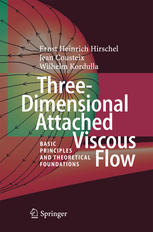

Most ebook files are in PDF format, so you can easily read them using various software such as Foxit Reader or directly on the Google Chrome browser.
Some ebook files are released by publishers in other formats such as .awz, .mobi, .epub, .fb2, etc. You may need to install specific software to read these formats on mobile/PC, such as Calibre.
Please read the tutorial at this link: https://ebookbell.com/faq
We offer FREE conversion to the popular formats you request; however, this may take some time. Therefore, right after payment, please email us, and we will try to provide the service as quickly as possible.
For some exceptional file formats or broken links (if any), please refrain from opening any disputes. Instead, email us first, and we will try to assist within a maximum of 6 hours.
EbookBell Team

0.0
0 reviewsViscous flow is treated usually in the frame of boundary-layer theory and as two-dimensional flow. Books on boundary layers give at most the describing equations for three-dimensional boundary layers, and solutions often only for some special cases.
This book provides basic principles and theoretical foundations regarding three-dimensional attached viscous flow. Emphasis is put on general three-dimensional attached viscous flows and not on three-dimensional boundary layers. This wider scope is necessary in view of the theoretical and practical problems to be mastered in practice.
The topics are weak, strong, and global interaction, the locality principle, properties of three-dimensional viscous flow, thermal surface effects, characteristic properties, wall compatibility conditions, connections between inviscid and viscous flow, flow topology, quasi-one- and two-dimensional flows, laminar-turbulent transition and turbulence.
Though the primary flight speed range is that of civil air transport vehicles, flows past other flying vehicles up to hypersonic speeds are also considered. Emphasis is put on general three-dimensional attached viscous flows and not on three-dimensional boundary layers, as this wider scope is necessary in view of the theoretical and practical problems that have to be overcome in practice.
The specific topics covered include weak, strong, and global interaction; the locality principle; properties of three-dimensional viscous flows; thermal surface effects; characteristic properties; wall compatibility conditions; connections between inviscid and viscous flows; flow topology; quasi-one- and two-dimensional flows; laminar-turbulent transition; and turbulence. Detailed discussions of examples illustrate these topics and the relevant phenomena encountered in three-dimensional viscous flows. The full governing equations, reference-temperature relations for qualitative considerations and estimations of flow properties, and coordinates for fuselages and wings are also provided. Sample problems with solutions allow readers to test their understanding.